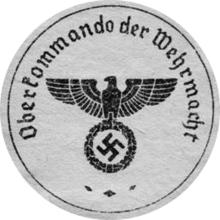
Back القيادة العليا للفيرماخت Arabic Vermaxt Ali Komandanlığı Azerbaijani Вярхоўнае камандаванне вермахта Byelorussian Главно командване на Вермахта Bulgarian Oberkommando der Wehrmacht Breton Oberkommando der Wehrmacht Catalan Oberkommando der Wehrmacht Czech Oberkommando der Wehrmacht Danish Oberkommando der Wehrmacht German Oberkommando der Wehrmacht Spanish
This article needs additional citations for verification. (July 2023) |
| Armed Forces High Command | |
|---|---|
| Oberkommando der Wehrmacht | |
 | |
| Active | 4 February 1938 – 23 May 1945 |
| Country | |
| Allegiance | |
| Type | High command |
| Role | Nominally oversaw: |
| Part of | Armed forces |
| Headquarters | Wünsdorf |
| Nickname(s) | OKW |
| Engagements | World War II in Europe |
| Commanders | |
| Chief of the OKW | Wilhelm Keitel |
| Chief of Operations Staff | Alfred Jodl |
| Insignia | |
| Chief of the OKW flag (1938–1941) |  |
| Chief of the OKW flag (1941–1945) |  |
The Oberkommando der Wehrmacht (German: [ˈoːbɐkɔˌmando deːɐ̯ ˈveːɐ̯ˌmaxt] ⓘ; abbreviated OKW German: [oːkaːˈveː] ⓘ; Armed Forces High Command)[1] was the supreme military command and control office of Nazi Germany during World War II. Created in 1938, the OKW replaced the Reich Ministry of War and had oversight over the individual high commands of the country's armed forces: the army (Heer), navy (Kriegsmarine), and air force (Luftwaffe). With the start of World War II, tactical control of the Waffen-SS was also exercised by it.[2]
Rivalry with the different services' commands, mainly with the Army High Command (OKH), prevented the OKW from becoming a unified German General Staff in an effective chain of command, though it did help coordinate operations among the three services. During the war, the OKW acquired more and more operational powers. By 1942, the OKW had responsibility for all theatres except for the Eastern Front. However, Adolf Hitler manipulated the system in order to prevent any one command from taking a dominant role in decision making.[3] This "divide and conquer" method helped put most military decisions in Hitler's own hands, which at times included even those affecting engagements at the battalion level,[3] a practice which, due to bureaucratic delays and Hitler's worsening indecision as the war progressed, would eventually contribute to Germany's defeat.
- ^ Stahel 2009, p. xiii.
- ^ Stein 2002, p. 23.
- ^ a b Megargee 1997.